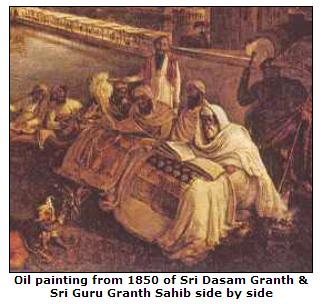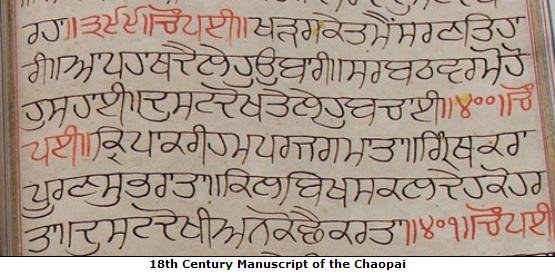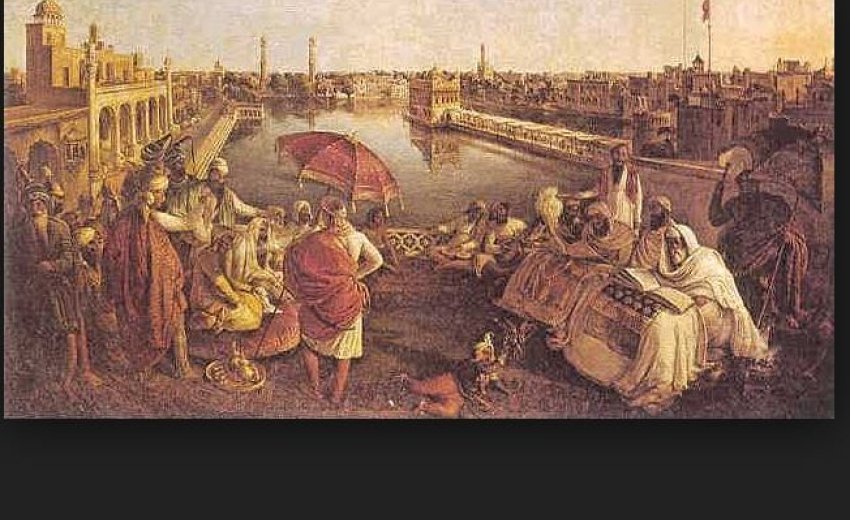 The British were the main agents in shortening Kabiyo Bach Benti Choupai (Chaupai Sahib) during their "British Raj" over India. The British sent a scout to Punjab to ascertain how many troops it would take to conquer the Punjab. The scout returned reporting that it would take all British troops in all of India to defeat the Punjab because the Sikhs have an inhuman bravery. Although Christian by religion they were willing to entertain that that the Sikhs derived power from their Banis, because of the unexplainable defeats in the past. It is said that one who reads Choupai Sahib is undefeatable. Choupai Sahib is the Bani for defeated ones enemies. This could be physical enemies like in the Guru's time, or it can be one's own vices. Through persistence and corruption the British managed not to directly conquer the Sikhs, but they accomplished something even more devastating. They were able to infiltrate Sikh management and compromise the daily 5 Banis. They were able to shorten Choupai Sahib and take off the last 2 pauris claiming that they are optional. The claim modern day Sikh leaders and intellectuals have is, "In modern times Sikhs don't have the time to read as many Banis as they used to". Another argument is that "Chaupai Sahib goes on and on in the Sri Dasam Granth so we have to stop somewhere." This is misleading because, as explained in detail below, we are talking about cutting a continuous portion of the Bani. Neither argument seems valid being that the last 2 pauris are only 4 lines and take about 15 seconds to read by a familiar practitioner. The fact is that the last 2 pauris have never been left out until recent history.
The British were the main agents in shortening Kabiyo Bach Benti Choupai (Chaupai Sahib) during their "British Raj" over India. The British sent a scout to Punjab to ascertain how many troops it would take to conquer the Punjab. The scout returned reporting that it would take all British troops in all of India to defeat the Punjab because the Sikhs have an inhuman bravery. Although Christian by religion they were willing to entertain that that the Sikhs derived power from their Banis, because of the unexplainable defeats in the past. It is said that one who reads Choupai Sahib is undefeatable. Choupai Sahib is the Bani for defeated ones enemies. This could be physical enemies like in the Guru's time, or it can be one's own vices. Through persistence and corruption the British managed not to directly conquer the Sikhs, but they accomplished something even more devastating. They were able to infiltrate Sikh management and compromise the daily 5 Banis. They were able to shorten Choupai Sahib and take off the last 2 pauris claiming that they are optional. The claim modern day Sikh leaders and intellectuals have is, "In modern times Sikhs don't have the time to read as many Banis as they used to". Another argument is that "Chaupai Sahib goes on and on in the Sri Dasam Granth so we have to stop somewhere." This is misleading because, as explained in detail below, we are talking about cutting a continuous portion of the Bani. Neither argument seems valid being that the last 2 pauris are only 4 lines and take about 15 seconds to read by a familiar practitioner. The fact is that the last 2 pauris have never been left out until recent history.
The British influence went to the extent of affecting Sikh management authorities, and printers. Nowadays, it may be difficult to find a Gutka with the entire Chaupai Sahib, and most Sikhs are not even aware that there are 27 pauris. The only NitNems (Gutkas) that have the entire Chaupai Sahib are printed by independent groups like Nihangs and Taksals. Under the leadership of the late Baba Santa Singh, printing presses were started to print "Nihang Gutkas", which are actually just the same Bania that were always practiced by the Nihangs. The duty of the Taksals are to take preserve the correct pronunciation and practice of the Banis. They print Nitnems with the entire Chaupai Sahib. The Nihangs never compromised to the British even in the face of extinction, and the Taksals have preserved the correct way of doing Banis since the Guru's time.
The British's strategy of 'Divide and Rule' went further than the shortening of Chaupai Sahib. Between 1922 and 1926 there was a puppet management committee set up by the British, who were set out to destroy the traditions. During this time, the (1) Mul Mantar was shortened to exclude 'Ad Sach, Jugad Sach...'. The Mul Mantar until "Gur Prasad' is known as the Maha Mantar, but the Mul Mantar always ends with 'Nanak Hosi Bhi Sach'. Maha Mantar is what God said to Guru Nanak, and the salok after Jap was what Guru Nanak said back. (2) The Raag Mala has debated and made optional. (3) Choupai Sahib was shortened, and (4) the "choti Anand Sahib" was altered. The first 5 pauris of Anand Sahib was included in Bhai Daya Singh's rehit nama when making Karah Prasad, but not 6. There isn't any reference where the last pauri (step) is placed after the first couple as if to assume that the whole Bani was completed, however this has become common practice. In the rehet is an abbreviation not a rearrangement. Now we can find "Nitnems" which do not contain the entire Anand Sahib at all, rather there is the first 5 and the 40th pauris of Anand Sahib. The intention being that if we just read the first 5 and the 40th then we can say Anand Sahib is done, and the complete Bani will be taken out of practice entirely.
The British took steps to eliminate the Sri Dasam Granth and all Banis contained within it. That would include Jaap Sahib, Tav Prasad Savaiye, Choupai Sahib, (3 of the 5 Banis of the Amrit ceremony) and Ardas. They outlawed the Kirpan, and Sikhs started splitting their Kangas and hiding a symbolic Kirpan inside. The British also un popularized Bana, because they didn't want Sikhs to have a strong identity. At one point Nihang Singhs were being persecuted by virtue of wearing Bana and gol dastara (round turbans). They were perceived as threats to the British infiltration because they were likely to fight back. Anyone wearing Bana and or a round turban would be picked up by British officers and 'taken away.' The British had killed all but 500 Nihangs and almost eliminated this denomination of Sikhism, the holders of the warrior spirit (see video). Nihang Singhs used to be a nomadic Gurdwara management group and now they live mostly secluded from mainstream Sikhism and from positions of power. Previous to the British occupation, the Sri Dasam Granth used to be in many Gurdwaras along side the Siri Guru Granth Sahib, and now it is mostly seen in Nihang villages and online, not to mention the many debates about it's authenticity. It is surprising that the British command is still being upheld today in the Sri Harimandir Sahib; the 'jakara' (warrior yell) was disallowed during the British rule, and the management still does not do a jakara after the Ardas in the Hari Mandir Sahib (although it is not prohibited to volunteers on other parts of the complex). Martial aspects of Sikhism have become mostly symbolic in modern times. The overall goal was to make Sikhism as a strictly Bakti (devotional) religion instead of the Shakti/Bakti (power/devotion) balance which it always had. With the Bir Ras (warrior spirit) Banis compromised, the Sikh identity disappearing, and martial aspects becoming purely symbolic the British had their way to control Sikhism. Then it was a matter of bribery, intimidation and manipulation of Sikh leaders to create a new 'modern Sikhism'.
Teja Singh Bhasauria was an employee of the British Government. He was given a School and funding to finance both the school and a printing press by the British. He intended to change Gurbani as directed to him by his British employees and his own ideas that were against the Hindu religion or any association to Hinduism in Gurbani. This has been recorded in history both by Prof sahib Singh, and by the fact that a Hukamnama ex-communicated him from the Akal Takht.
One of his associates Giani Kartar Singh Kalaswalia was the head Granthi of Sri Harimandir Sahib. It was during his term of seva that the Chaupai and Dohira were removed. Teja Singh's son Ran Singh, wrote Dasam Granth Nirney in 1919, in which he claims that another Bani starts after the 25th pauri - Dustt dokh tay layho bachaaee. This is untrue. This is the first reference to the short Chaupai Sahib. Before this time there has not been discovered any reference of anything but the full Chaupai Sahib.
The one thing that is very striking about this history is for the first time in Sikh history the Banis have been compromised. Until the British Raj, Sikhs had given their lives to preserve every word of the Siri Guru Granth Sahib and the Siri Dasam Granth. There are many Sikh issues today; lack of leadership, terrorism backlash, women's seva issues. Amongst all issues Sikhs could always go to the Shabad Guru knowing that it was exactly how the Gurus wrote it with Their own Hands. This is one thing that stands out about Choupai Sahib. Every Sikh knows the importance of the Shabad Guru being preserved. Guru Har Rai, who was so gentle that he couldn't even harm a flower, disowned his own son for changing one word of the Adi Granth. Now a full 2 pauris have been taken out of Sikh daily practice. There are ripe complaints amongst Sikhs that the overall Panth is not united, Sikh leaders are corrupt, Sikh youth are leaving their roots, etc. This could be because some of the fundamental practices have been compromised. Bana, Bani, Simran, Seva, and Shastar were given by Guru Gobind Singh so that Sikhs could have his blessing and his spirit against all odds. Now Bana is mostly out of practice and Bani has been shortened.
It is important to note that we are not talking about the rearranging of different sections of Banis, but the cutting off of pauris from one continuous Bani. Lets compare it with Rehiras Sahib. Rehiras Sahib as a whole has been rearranged throughout time and depending on which Jetha is promoting which version. Some Nihang versions are much longer than most versions, but no version ends So Purakh before its last pauri. We all know that Tav Prasad Savaiye has 10 pauris and Anand Sahib has 40 pauris. To take off the last 2 pauris of Choupai Sahib could be compared to taking off the last 2 pauris of Japji Sahib; ending at the 36th pauri (instead of the full 38) and then reading the Slok. Even in modern times it is difficult to justify this kind of amendment to Guru Gobind Singhs 5 Banis. The common practice is to jump from the 25th pauri to the Savaiye. After the obvious conclusions drawn from the history we know to read up to the 27th pauri. So what comes after that? Different groups practice Chaupai Sahib differently. Some versions have a lot of the part of Sri Dasam Granth that follows Chaupai as it's written. For the average practitioner, several Babas have made it clear that the Arril must be read. More than that, it is customary to read the Savaiye and Dohra to finish the Bani. Savaiye and Dohra are complete titles that are compiled onto Choupai from another part of the Sri Dasam Granth. This is similar to Rehiras where we have Shabads from different places in the Siri Guru Granth put together to make the Rehiras. Please note that we are not taking only parts of a complete section. The complete sections of Chaupai Sahib are as follows:
The common practice is to jump from the 25th pauri to the Savaiye. After the obvious conclusions drawn from the history we know to read up to the 27th pauri. So what comes after that? Different groups practice Chaupai Sahib differently. Some versions have a lot of the part of Sri Dasam Granth that follows Chaupai as it's written. For the average practitioner, several Babas have made it clear that the Arril must be read. More than that, it is customary to read the Savaiye and Dohra to finish the Bani. Savaiye and Dohra are complete titles that are compiled onto Choupai from another part of the Sri Dasam Granth. This is similar to Rehiras where we have Shabads from different places in the Siri Guru Granth put together to make the Rehiras. Please note that we are not taking only parts of a complete section. The complete sections of Chaupai Sahib are as follows:
1) Kabiyo Bach Benti Chaupai
2) Arril and Chaupai (which follows Benti Chaupai as written in the Sri Dasam Granth. These short stanzas act as a conclusion to this Bani before the Zafarnama)
3) Savaiye and Dohra (compiled from an earlier section of Sri Dasam Granth)
Some modern day Sikhs refute the Sri Dasam Granth for its many references to Hindu mythology. This is surprising because the Siri Guru Granth Sahib has many references of the same. So why was it cut after the 25th pauri instead of any other place? It could be because the 26th pauri references 'Jag Mata' (Mother of the World) which could be confused as Hindu goddess worship. Whereas, Guru Ji is using the Mother analogy as one of the many aspects of God. At the end of Japji Sahib, Guruji refers to 'Mata Dharat' - Mother of the World. In this instance the Guru has decided to represent God through the feminine creative aspect.
It is said that the end and beginning have the most power in any given composition. The last 2 pauris of Chaupai Sahib contain a lot of power. The first 25 pauris are asking God's blessings, and the last 2 are very affirmative of owning the blessings. In the last line Guru Gobind Singh gives his guarantee to the reader:
[Man ba(n)chhat phal pavai soee. Dukh na tisai biaapat koee. (27)
He will obtain the fruit desired by the mind (who will read or listen to this book) and no suffering will occur to him. (27)]
Let us take the Guru's blessing by keeping the seal of the last 2 pauris and experience the power that it gives.
